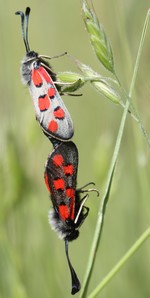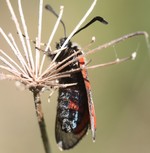| |
| |  | |  | | |
| | numbering of the spots | | | | |
| | | | | | | |
| | | | | | | |
| | choice A |  | - 6 red spots, spot No.6 can be small and even hardly visible
- no red belt
- spots No.3&No.4 can be remote from each other or touch each other
|  |  | next step >> |
| | | | | | | |
| | | | | | | |
| | | | | | | |
| | choice B |  | - 6 red or pinkish spots (sometimes with white inside)
- bold red belt
- spot No.6 can be small and even hardly visible
- spots No.3&No.4 do not touch each other
|  |  | next step >> |
| | | | | | | |
| | | | | | | |
| | | | | | | |
| | choice C |  | - 6 red spots of similar size
- bold red belt or very inconspicuous
- the forewing shows a dark or bright grey color
- spots No.2,3,4&5 include black markings which look like 'hyphens' on the front part and on the back part of these spots
- local species living in the South-East of France
| |  | |
| | | | | | | |
| | | | | | | |
| | | | | | | |
| | | | | | | |
| | | | | | | |
| | | | | | | |
| | | | | | | |
| | | | | | | |
| | | | | | | |
| | | | | | | |













